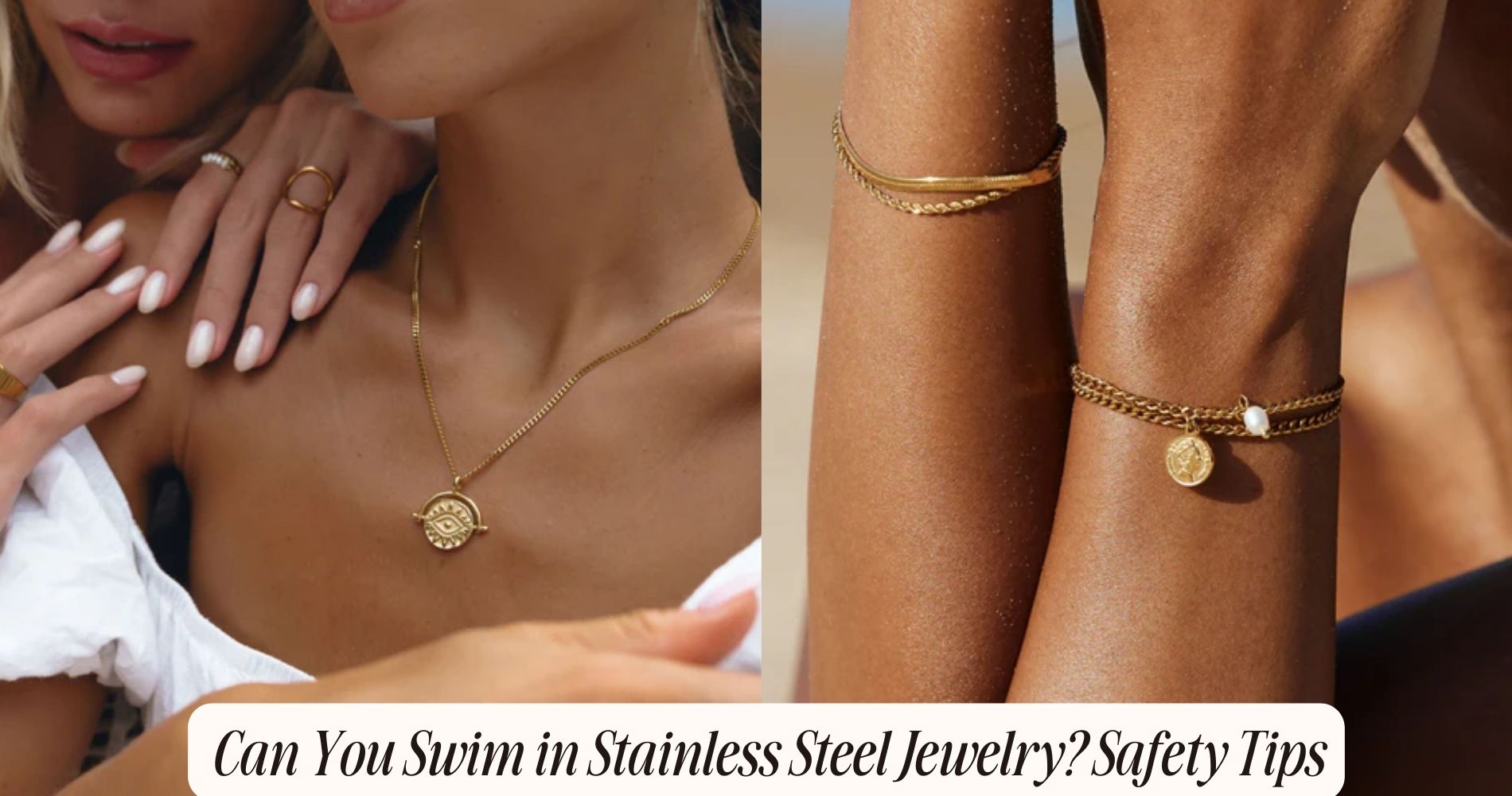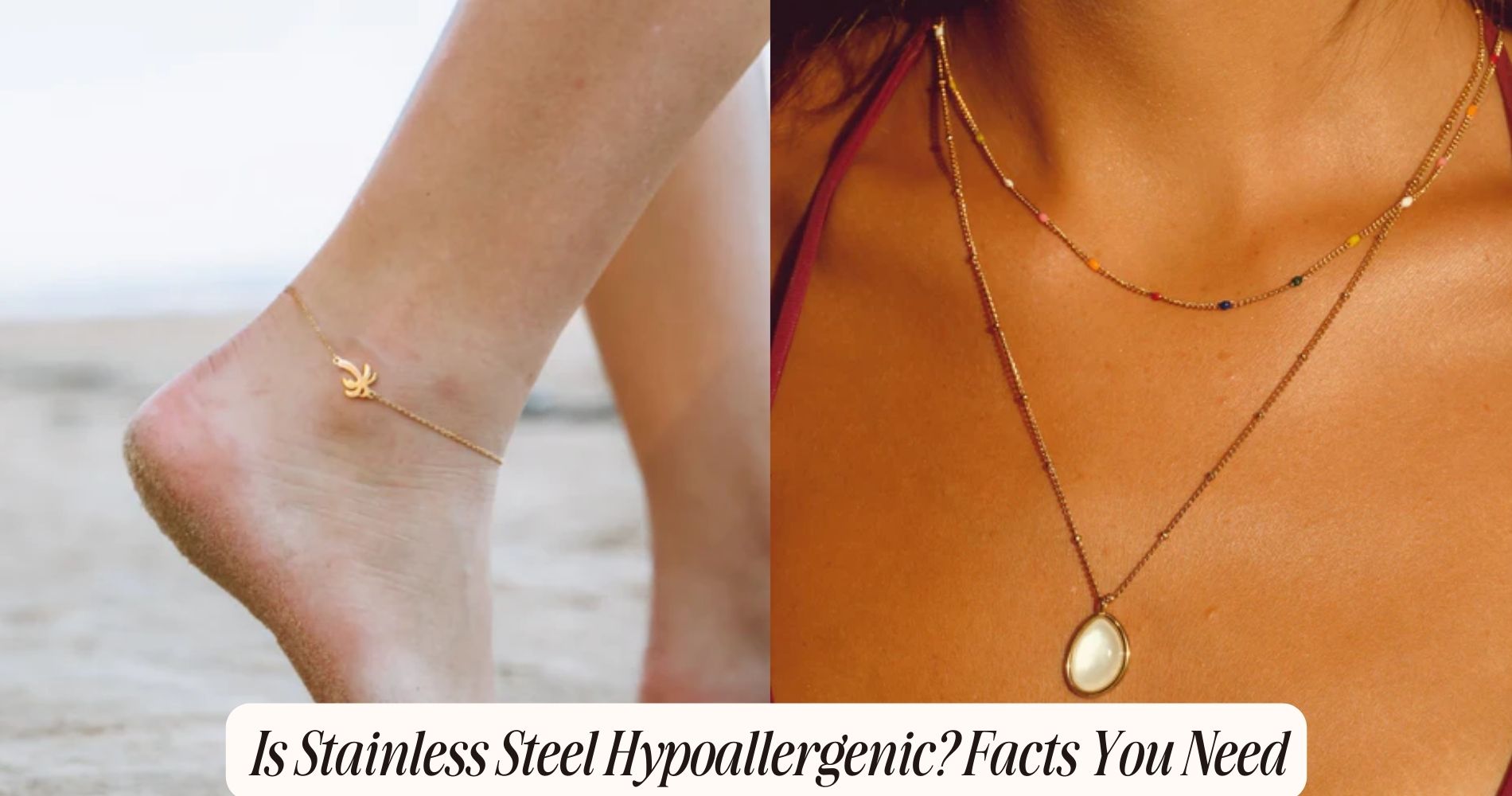
Can You Swim in Stainless Steel Jewelry? Safety Tips
Understanding Stainless Steel Jewelry
Stainless steel jewelry, known for its durability and resistance to tarnish, is crafted from an alloy of iron, carbon, and chromium. This combination not only makes the jewelry robust but also gives it a sleek, modern appearance. You'll find a variety of design variations, ranging from minimalist bands to intricate pendants, making it easy to choose pieces that match your style. The alloy's composition guarantees that these pieces maintain their luster over time, even with frequent wear.
What sets stainless steel jewelry apart is its hypoallergenic properties. If you have sensitive skin, you'll appreciate that this type of jewelry is less likely to cause irritation or allergic reactions compared to other metals. The chromium in the alloy forms a protective layer, preventing the metal from reacting with your skin. This feature makes stainless steel a go-to choice for those who want both fashion and comfort.
In essence, stainless steel jewelry offers a blend of aesthetic appeal and practical benefits. Its design variations cater to different tastes, and its hypoallergenic properties provide peace of mind for people with skin sensitivities. Understanding these characteristics will help you make informed choices about wearing and caring for your jewelry.
Effects of Chlorine and Saltwater
When you swim in chlorinated pools or saltwater, your stainless steel jewelry faces risks of corrosion and discoloration. Chlorine can react with the metal, causing it to weaken and lose its luster over time.
Similarly, saltwater's high salinity can erode the protective layer, affecting the jewelry's durability.
Corrosion and Discoloration Risks
Exposure to chlorine in pools and saltwater in the ocean can greatly enhance the risk of corrosion and discoloration in your stainless steel jewelry. Although stainless steel is known for its durability and resistance to rust, the chemical properties of chlorine and saltwater can compromise its integrity.
Chlorine, often used in pools, is a harsh chemical that accelerates the breakdown of the protective chromium oxide layer on stainless steel. Once this layer is damaged, your jewelry becomes susceptible to corrosion.
Saltwater, with its high salinity, can similarly affect stainless steel. The salt can penetrate the metal surface, leading to pitting corrosion, which not only tarnishes the appearance but also weakens the metal structure. This process can be particularly aggressive if the jewelry has any imperfections from the manufacturing process, making it more vulnerable to these elements.
Additionally, the risk of allergic reactions can increase if the protective layer is compromised, exposing you to nickel and other metals often used in stainless steel alloys. To maintain the longevity and aesthetic appeal of your stainless steel jewelry, it's advisable to minimize exposure to chlorine and saltwater whenever possible.
Chlorine's Impact on Jewelry
Chlorine, a common pool additive, aggressively attacks the protective chromium oxide layer on your stainless steel jewelry, leading to rapid corrosion and unsightly discoloration. When you swim in a chlorinated pool, the chlorine molecules engage in chemical reactions with the chromium oxide layer that shields your jewelry from rust and tarnish. This degradation exposes the underlying metal to further chemical reactions, accelerating the corrosion process.
Proper pool maintenance often involves adding chlorine to maintain the water clean and free from bacteria. However, this same chlorine that guarantees a safe swimming environment can wreak havoc on your stainless steel jewelry. Extended exposure to chlorinated water can result in pitting, weakening the structural integrity of your pieces and causing them to lose their lustrous finish.
To mitigate these effects, it's best to remove your stainless steel jewelry before taking a dip in the pool. If you do swim with it, rinse your jewelry thoroughly with fresh water afterward to remove any residual chlorine.
Saltwater's Effect on Durability
Saltwater, with its high sodium chloride content, poses a notable threat to the durability of your stainless steel jewelry. While stainless steel is known for its corrosion resistance, prolonged exposure to saltwater can expedite wear and tear. The salt crystals can penetrate tiny crevices in the metal, leading to pitting and eventual corrosion over time.
When you swim in the ocean, you're not just encountering saltwater; you're also exposing your jewelry to marine biodiversity. Tiny organisms and algae can latch onto the metal surface, creating a biofilm that can be challenging to remove. This biological layer can further compromise the integrity of your jewelry, making it more susceptible to damage.
Additionally, the abrasive action of sand and particles suspended in the water, accelerated by coastal erosion, can scratch and dull the surface of your stainless steel pieces. This mechanical wear, combined with chemical corrosion, significantly reduces the lifespan of your jewelry.
To maintain the integrity of your stainless steel jewelry, it's best to remove it before swimming in the ocean. Rinse your jewelry with fresh water immediately if it does come into contact with saltwater, and dry it thoroughly to prevent any long-term damage.
Benefits of Stainless Steel in Water
Thanks to its corrosion-resistant properties, stainless steel jewelry remains durable and visually appealing even when frequently exposed to water. Whether you're swimming in a pool or enjoying a day at the beach, stainless steel's hypoallergenic properties guarantee that it won't irritate your skin. This makes it an excellent choice for those with sensitive skin who still want to enjoy their aquatic activities without discomfort.
Moreover, the versatility in design of stainless steel jewelry means you can find pieces that suit any style, from minimalist to intricate designs. This flexibility allows you to make a fashion statement without worrying about water damage. The metal's robustness ensures that your jewelry maintains its shine and shape even after repeated exposure to chlorinated or salty water.
Additionally, stainless steel is incredibly low-maintenance. A quick rinse with fresh water after swimming can help maintain its luster, and it doesn't require frequent polishing or special cleaning solutions. This ease of care makes stainless steel jewelry ideal for those with active lifestyles who don't want to compromise on style or durability.
With these benefits, stainless steel stands out as a reliable choice for water-resistant jewelry.
Risks of Wearing Jewelry While Swimming
Understanding the potential risks associated with wearing any type of jewelry while swimming is essential, even though stainless steel jewelry offers many benefits. One primary concern is skin irritation. Chlorine in swimming pools can react with metals, potentially leading to rashes or other skin issues. Even though stainless steel is generally resistant to corrosion, prolonged exposure to chlorinated water can still cause minor reactions, especially if you have sensitive skin.
Another significant risk includes safety hazards. Jewelry can easily get caught on pool equipment, swimwear, or even other swimmers. This can lead to accidental injuries, such as cuts or bruises, and in severe cases, drowning risks if you get entangled. Additionally, the force of water can dislodge rings, bracelets, or necklaces, increasing the chances of losing valuable pieces.
In open water scenarios, such as oceans or lakes, jewelry can attract unwanted attention from marine life, posing additional safety hazards. The reflective surfaces of stainless steel can mimic baitfish, potentially inviting curious or predatory fish.
While stainless steel jewelry is durable, it's wise to weigh its risks before deciding to swim with it. Always prioritize your safety and skin health.
Cleaning and Maintenance Tips
To keep your stainless steel jewelry looking its best, regular cleaning and maintenance are crucial.
First, you'll want to focus on tarnish prevention. Although stainless steel is resistant to tarnish, elements like chlorine and saltwater can still cause it to lose its luster over time. After swimming, rinse your jewelry with fresh water to remove any residual chemicals.
When it comes to cleaning solutions, a simple mixture of mild soap and warm water will do wonders. Create the solution, then use a soft cloth or a gentle brush to scrub your jewelry. Avoid abrasive cleaners, as they can scratch the metal. Rinse thoroughly and dry with a lint-free cloth to prevent water spots.
For deeper cleaning, consider using a specialized stainless steel cleaner. These products are designed to remove stubborn dirt and restore shine without damaging the metal. Always follow the manufacturer's instructions for best results.
In addition, regular polishing can help maintain your jewelry's appearance. Use a microfiber cloth to buff the surface, enhancing its natural shine.
Storing Jewelry After Swimming
After guaranteeing your stainless steel jewelry is thoroughly cleaned and dried, proper storage is key to maintaining its quality. You should begin by employing effective drying techniques, such as gently patting the jewelry with a soft, lint-free cloth. Make sure that every part, including crevices and intricate details, is completely dry to prevent any moisture-related tarnish or corrosion.
Once your jewelry is dry, store it in a manner that minimizes exposure to air and humidity. Storing pouches made from soft materials like cotton or velvet are excellent choices. These pouches protect your jewelry from scratches and reduce the risk of exposure to elements that cause tarnishing. Additionally, consider storing each piece separately in individual pouches to avoid scratching and entanglement.
You might also use airtight containers or jewelry boxes with anti-tarnish linings. These specialized storage options provide an extra layer of protection against environmental factors that could dull the shine of your stainless steel jewelry over time.
Frequently Asked Questions
How Long Can Stainless Steel Jewelry Last if Used Regularly in Water?
If you wear stainless steel jewelry regularly in water, it can last years. However, chlorine exposure and water hardness can cause gradual wear. Rinse and dry your jewelry after each swim to maintain its appearance.
Are There Any Specific Brands of Stainless Steel Jewelry Recommended for Swimmers?
When choosing stainless steel jewelry for swimming, consider brand reputation and material composition. Reputable brands like Tiffany & Co. and Kay Jewelers guarantee high-quality stainless steel, offering durability and resistance to corrosion, making them ideal for swimmers.
Can Swimming in Stainless Steel Jewelry Cause Skin Irritation or Allergies?
Swimming in stainless steel jewelry can cause skin irritation or allergies if you have nickel allergies. Chlorine effects might also exacerbate sensitivity, so it's best to monitor your skin closely when wearing jewelry in the pool.
What Is the Best Way to Dry Stainless Steel Jewelry After Swimming?
To dry stainless steel jewelry after swimming, use effective drying techniques like patting it with a soft cloth and ensuring moisture prevention by allowing it to air dry completely. This maintains the jewelry's integrity and prevents damage.
How Does the Weight of Stainless Steel Jewelry Affect Swimming Performance?
The weight of stainless steel jewelry can impact your swimming performance by increasing water resistance and altering buoyancy effects. Heavier pieces may hinder your speed and agility, making it harder to move efficiently through the water.
Conclusion
To sum up, you can swim in stainless steel jewelry, but it's important to be cautious. Chlorine and saltwater can impact the metal's appearance over time.
To minimize risks, clean and dry your jewelry after swimming, and store it properly. Consider alternative accessories designed for swimmers if you frequently hit the pool.
By following these tips, you'll maintain the beauty and longevity of your stainless steel pieces while enjoying your aquatic activities.























Leave a comment
This site is protected by hCaptcha and the hCaptcha Privacy Policy and Terms of Service apply.